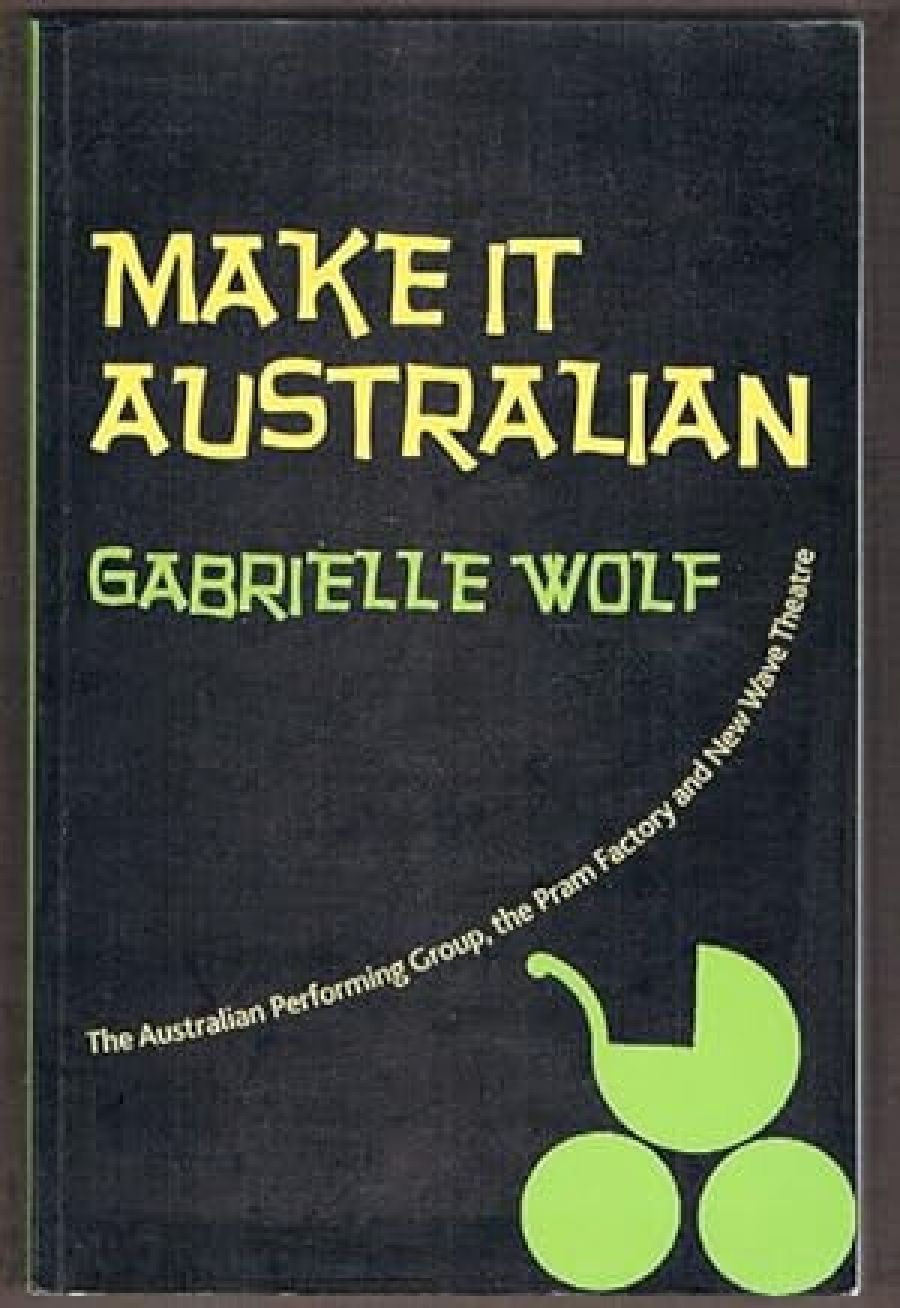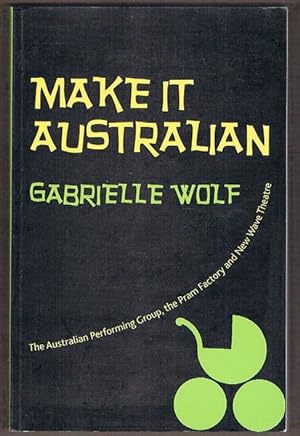
- Free Article: No
- Contents Category: Non-fiction
- Custom Article Title: Days in FitzCarlton
- Review Article: Yes
- Article Title: Days in FitzCarlton
- Online Only: No
- Custom Highlight Text:
The Australian Performing Group (APG) and its associated theatre space, the Pram Factory, form one of the legends of Australian theatre. And like all legends, the stories that people tell of it inevitably conflate the truth of what it actually was – or wasn’t, as the case may be. Somewhere back in 1969 – or was it 1970? – a group of enthusiastic thespians decided to take on the world (or at least their own preconceptions of it), and shake up the theatrical Establishment. Legend has it that Australian theatre has never been the same since.
- Book 1 Title: Make it Australian
- Book 1 Subtitle: The Australian Performing Group, the Pram Factory and New Wave theatre
- Book 1 Biblio: Currency Press, $39.95 pb, 304 pp
- Book 1 Cover Small (400 x 600):

- Book 1 Cover (800 x 1200):

Gabrielle Wolf’s book Make It Australian, the most recent history of the APG, is an attempt to resist the mythical impetus of accretion and conflation of this legacy, and to bring some order and clarity to what actually took place over those dozen or so years. With painstaking research into the archives of the APG and the Pram, Wolf cuts through the fog of memory, ideology and theatre-dazzle to bring us the story of the productions that charted New Wave theatre in Melbourne from the founding of La Mama in 1967 to the ultimate demise of the APG in 1981, when the Pram Factory premises disappeared into what is now a shopping mall.
There is a paradox in this approach, however. Detached from the passionate and emotive material, the subject itself is somewhat neutered, as the emotion and revolutionary zeal disappears into the critical background. This is one of those books that never quite overcomes its origins as a doctoral thesis, and the academic methodology is ultimately the book’s undoing. It tends to read like the minutes of the endless committee meetings that make up the bulk of Wolf’s primary source material.
There is, nevertheless, much to praise in this account. Wolf’s assured chronological narrative brings an admirable clarity to the development of the APG – a clarity that the actual practitioners of the Group could probably never articulate themselves. All the significant productions are discussed, as well as the major debates that so energised (and divided) the Group. Issues such as nationalism in programming, ockerism, gender representation, acting styles and directors, are all put in context. Likewise, the various splinterings of the Group are discussed, without bias or favour for the competing artistic and political motivations of those involved.
Wolf achieves this fair representation through her many quotations from the series of interviews she conducted with members of the APG. We hear from Bill Garner on what it was like to explore ockerism on stage; Kerry Dwyer on the need for women’s roles; Peter Cummins on the oddities of being Monk O’Neill; and Peter Corrigan regretting the prevalence of drugs at the Pram. Rummaging through the archives also finds Graeme Blundell expounding the need for a nationalist theatre, as well as the banal discussions about whose turn it was to do the cleaning.
These voices lend great authenticity to the account, but they tend to lessen the pace of the book. The prose is littered with formulaic phrases such as ‘Romeril recalls’, ‘Singleton remembers’, ‘according to Gillies’, ‘Oakley reflects’. So profuse are the voices that Wolf’s own position always seems in reserve. More than once you want the author to come out say such-and-such a project was, in hindsight, a pile of baloney, or to let us know what she really thinks about rival factions such as Nightshift and Stasis. But Wolf is determinedly impartial, and the few times she does step into the narrative in a ficto-critical mood are too coy and self-conscious to constitute a real analytical position.
Despite the causal clarity that emerges from the chronological structure, there are times when the book could afford to debate an issue more deeply or broadly. For example, with regard to the APG’s insistence on the production of Australian works for Australian audiences, there is scant linkage of this to wider cultural formations, such as the nationalist film project of the 1970s. Although there are gestures to some of the international ideas that were the germ of the APG style, this subject really warrants more analysis. To be fair, Wolf does refer to the parallel developments at Nimrod, but there could be more contextualisation. As it is, the APG seems to survive in its insular bubble of FitzCarlton.
The great benefit of this book will be to future researchers wanting to take advantage of Wolf’s meticulous study of the enormous archives that the APG generated about itself. There is a problem here too, however. The book has more than one thousand endnotes. These should constitute a goldmine of references, but the presentation of the notes is perhaps the most frustrating I have ever encountered. The forty pages of endnotes provide no useful indexing, so it is necessary to flick back and forth to locate the particular chapter for each endnote. The source of the note might be an article – Bill Garner’s invaluable paper ‘The APG: What Is It?’, for example – but the full citation is only given the first time it is mentioned, so if you actually want to follow up the reference, you must trawl back through a few hundred more notes to get the information you want. A more complete bibliography would help, as well as a simple header in the endnotes, telling the reader what pages they refer to. It is to be hoped that a second edition will address this.
What stands out, looking back at the period of the APG’s existence, is the enormous energy and volume of creativity. Hibberd seems to have written a play a month, a bit like his APG associate David Williamson, who famously went on to write a mainstage play every year to feed the subscription audiences of first the MTC and later the STC. That dynamism and sheer cockiness is absent from playwriting in Australia today, just as the role of local content in the programming of our main companies is fraught and precarious.
In 1972 and 1973 the Melbourne Theatre Company produced all-Australian seasons. It would be a courageous director who would propose such a season today: the last experiment of the kind, by the South Australian Theatre Company in the 1990s, petered out with a whimper. It is notable that the most exciting Melbourne company of the past few years, Red Stitch Actors Theatre, has made its name almost exclusively on the back of new plays from North America, England and Ireland. You could say that this means Australian theatre has matured with a true internationalist outlook – or you might just say we need the APG all over again, to ‘Make it Australian’.


Comments powered by CComment